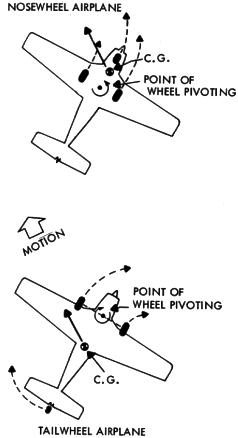After Landing Roll
After Landing Roll
| The landing process must never be considered complete until the airplane
decelerates to the normal taxi speed during the landing roll or has been
brought to a complete stop when clear of the landing area. Many accidents
have occurred as a result of pilots abandoning their vigilance and positive
control after getting the airplane on the ground.
The pilot must be alert for directional control difficulties immediately
upon and after touchdown due to the ground friction on the wheels. The
friction creates a pivot point on which a moment arm can act. This is especially
true in tailwheel type airplanes because unlike nosewheel type airplanes,
the center of gravity (CG) is behind the main wheels (Fig. 9-10). Any difference
between the direction the tailwheel type airplane is traveling and the
direction it is headed will produce a moment about the pivot point of the
wheels and the airplane will tend to swerve. Nosewheel type airplanes make
the task of directional control much easier because the center of gravity
being ahead of the main landing wheels, presents a moment arm which tends
to straighten the airplane's path during the touchdown and after landing
roll. However, this should not lull the pilot into a false sense of security.
Loss of directional control may lead to an aggravated, uncontrolled,
tight turn on the ground, or a "ground loop." The combination of centrifugal
force acting on the CG and ground friction of the main wheels resisting
it during the ground loop may cause the airplane to tip or lean enough
for the outside |

|
|

|
wingtip to contact the ground, and may even impose a sideward force which
could collapse the landing gear. Tailwheel type airplanes are most susceptible
to ground loops late in the after landing roll because rudder effectiveness
decreases with the decreasing flow of air along the rudder surface as the
airplane slows.
The rudder serves the same purpose on the ground as it
does in the air - it controls the yawing of the airplane. The effectiveness
of the rudder, however, is dependent on the airflow which, of course, depends
on the speed of the airplane. As the speed decreases and the nosewheel
or tailwheel has been lowered to the ground, the steerable nose or tailwheel
provides more positive directional control.
The brakes of an airplane serve the same primary purpose
as do the brakes of an automobile - that is, to reduce speed on the ground.
In airplanes, however, they may also be used as an aid in directional control
when more positive control is required than could be obtained with rudder,
nosewheel steering, or tailwheel steering alone.
To use brakes, the pilot should slide the toes or feet
up from the rudder pedals to the brake pedals. If rudder pressure is being
held at the time braking action is needed, that pressure should not be
released as the feet or toes are being slid up to the brake pedals, because
control may be lost before brakes can be applied.
During the ground roll, the airplane's direction of movement
may be changed by carefully applying pressure on one brake or uneven pressures
on each brake in the desired direction. Caution must be exercised, however,
when applying brakes to avoid overcontrolling.
The ailerons, too, serve the same purpose on the ground
as they do in the air - they change the lift and drag components of the
wings. During the after landing roll they should be used to keep the wings
level in much the same way they were used in flight. If a wing starts to
rise, aileron control should be applied toward that wing to lower it. The
amount required will depend on speed because as the forward speed of the
airplane decreases, the ailerons will become less effective. Techniques
for using ailerons in crosswind conditions ar explained further in the
section on crosswind landings.
After a nosewheel type airplane is on the ground, back
pressure on the elevator control may be gradually relaxed to place normal
weight on the nosewheel to aid in better steering.
With a tail wheel type airplane, the elevator control should
be held back as far as possible and as firmly as possible, until the airplane
stops. This provides more positive control with tailwheel steering, tends
to shorten the after landing roll, and prevents bouncing and skipping.
If available runway permits, the speed of the airplane
should be allowed to dissipate in a normal manner by the friction and drag
of the wheels on the ground. Brakes may be used if needed to help slow
the airplane.
After the airplane has been slowed sufficiently and has
been turned onto a taxiway or clear of the landing area, it should be brought
to a complete stop. Only after this is done should the pilot retract the
flaps and "clean up" the airplane. Too many accidents have occurred as
a result of the pilot unintentionally operating the landing gear control
and retracting the gear instead of the flap control when the airplane was
still rolling. The habit of positively identifying either of these controls
before actuating them, should be formed from the very beginning of flight
training and continued in all future flying activities.
